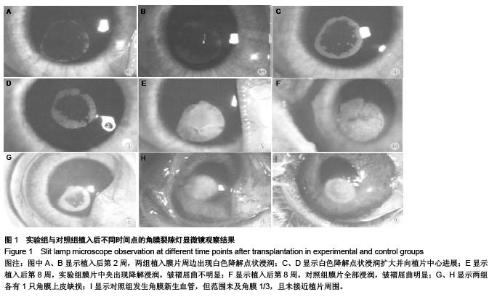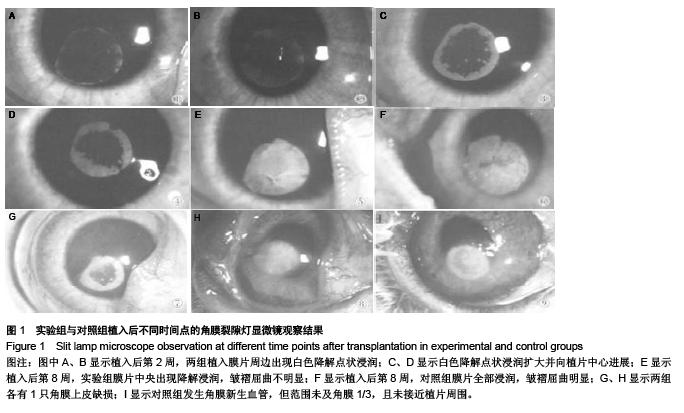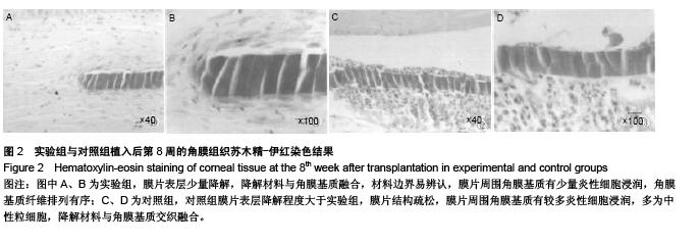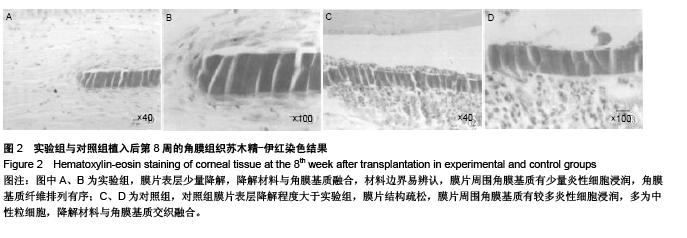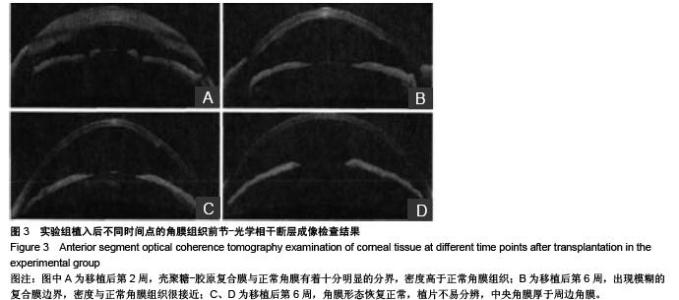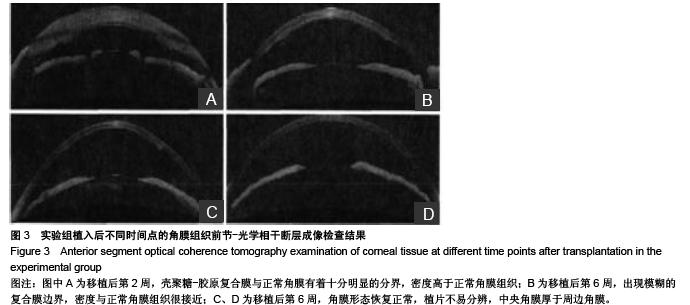Chinese Journal of Tissue Engineering Research ›› 2015, Vol. 19 ›› Issue (52): 8433-8437.doi: 10.3969/j.issn.2095-4344.2015.52.013
Previous Articles Next Articles
Preparation and biocompatibility of chitosan-collagen corneal repair materials
Du Qian
- Department of Ophtalmology, Nanyang City Center Hospital, Nanyang 473000, Henan Province, China
-
Received:2015-11-11Online:2015-12-17Published:2015-12-17 -
About author:Du Qian, Master, Attending physician, Department of Ophtalmology, Nanyang City Center Hospital, Nanyang 473000, Henan Province, China
CLC Number:
Cite this article
Du Qian. Preparation and biocompatibility of chitosan-collagen corneal repair materials[J]. Chinese Journal of Tissue Engineering Research, 2015, 19(52): 8433-8437.
share this article
| [1] 黄飞华,孔繁智,朱婉萍,等.不同相对分子质量壳聚糖乳酸盐体外抑菌实验研究[J].中国海洋药物,2009,28(2):36-39.
[2] 李玉文,张梁栋.甲壳素及其衍生物在医药领域的应用[J].潍坊学院学报,2011, 11(4):80-84.
[3] Pillai CKS,Paul W,Sharma CP.Chitin and chitosan polymers: chemistry, solubility and fiber formation.Prog Polym Sci. 2009; 34(7):641-678.
[4] Cheba BA.Chitin and chitosan:marine biopolymers with unique properties and versatile applications.Global J Biotech Bio-Chem.2011;(3):149-153.
[5] 马群,刘万顺,韩宝芹,等.角膜组织工程支架壳聚糖基共混膜 的制备及性能评价[J].功能材料,2010,41(9):1547-1551.
[6] Liang Y, Liu W, Han B,et al.Fabrication and characters of a corneal endothelial cells scaffold based on chitasan.J Mater Sci: Mater Med.2011;22(1):175-183.
[7] Keogh MB,O' Brien FJ,Daly JS.A novel collagen scaffold supports human osteogenesis--applications for bone tissue engineering.Cell Tissue Res.2010;340(1):169-177.
[8] 王家鸣,任力,龙玉宇,等.壳聚糖-胶原复合膜渗透性能的研究[J].功能材料,2012,43(20):2747-2750.
[9] Wang L,Stegemann JP.Thermogelling chitosan and collagen composite hydrogels initiated with beta-glycerophosphate for bone tissue engineering. Biomaterials. 2010;31(14): 3976- 3985.
[10] 马群,刘万顺,韩宝芹,等.角膜组织工程支架壳聚糖基共混膜的制备及性能评价[J].功能材料,2010,41(9):1547-1551.
[11] Venugopal J,Prabhakaran MP,Zhang Y,et al.Biomimetic hydroxyapatite-containing composite nanofibrous substrates for bone tissue engineering.Philos Trans A Math Phys Eng Sci. 2010;368(1917):2065-2081.
[12] Melton JT,Wilson AJ,Chapman-Sheath P,et al.TruFit CB bone plug: chondral repair, scaffold design, surgical technique and early experiences.Expert Rev Med Devices. 2010; 7(3): 333- 341.
[13] 龙玉宇,任力,王家鸣,等.角膜修复用改性明胶交联膜的生物相容性评价[J].生物医学工程学杂志,2013,20(1):170-175.
[14] Badawi AA,El-Laithy HM,El Qidra RK,et al.Chitosan based nanocarriers for indomethacin ocular delivery.Arch Pharm Res.2008;31(8):1040-1049.
[15] Shah A,Brugnano J,Sun S,et al.The development of a tissue-engineered cornea: biomaterials and culture methods. Pediatr Res.2008;63(5):535-544.
[16] 王雪,颜华.组织工程角膜上皮支架材料研究进展[J].眼科研究, 2010,28(10):998-1002.
[17] Bu P, Vin AP, Sethupathi P,et al. Effects of activated omental cells on rat limbal corneal alkali injury.Exp Eye Res. 2014;121: 143-146.
[18] Murphy CM, O'Brien FJ.Understanding the effect of mean pore size on cell activity in collagen-glycosaminoglycan scaffolds.Cell Adh Migr.2010;4(3):377-381.
[19] 侯江平,李国星,李玉莉,等.角膜内不同部位植入壳聚糖-胶原复合膜的生物相容性[J]. 中国组织工程研究与临床康复, 2010, 14(34):6319-6322.
[20] Hongyok T,Chae JJ,Shin YJ,et al.Effect of chitosan-N- acetylcysteine conjugate in a mouse model of botulinum toxin B-induced dry eye.Arch Ophthal mol. 2009;127(4):525-532.
[21] 郭丽,王迎军,任力,等.明胶固定化壳聚糖膜的细胞相容性评价[J].功能材料,2009,40(9):1525-1528.
[22] Qu C,Xiong Y,Mahmood A,et al.Treatment of traumatic brain injury in mice with bone marrow stromal cell-impregnated collagen scaffolds.J Neurosurg.2009;111(4):658-665.
[23] Notara M,Hernandez D,Mason C,et al.Characterization of the phenotype and functionality of corneal epithelial cells derived from mouse embryonic stem cells.Regen Med. 2012; 7(2): 167-178.
[24] Hu K,Shi H,Zhu J,et al.Compressed collagen gel as the scaffold for skin engineering.Biomed Microdevices. 2010; 12(4): 627-635.
[25] 周晓伟,李国星,朱显丰,等.壳聚糖胶原复合膜在兔角膜基质层间的组织相容性[J].眼视光学杂志,2009,11(6):419-426.
[26] Wang F,Li Y,Shen Y,et al.The functions and applications of RGD in tumor therapy and tissue engineering.Int J Mol Sci. 2013;14(7):13447-13462.
[27] 李娜,周伟,孙恒.人工角膜的研究进展[J].医学综述, 2009,15(4): 575-579. |
| [1] | Chen Ziyang, Pu Rui, Deng Shuang, Yuan Lingyan. Regulatory effect of exosomes on exercise-mediated insulin resistance diseases [J]. Chinese Journal of Tissue Engineering Research, 2021, 25(25): 4089-4094. |
| [2] | Chen Yang, Huang Denggao, Gao Yuanhui, Wang Shunlan, Cao Hui, Zheng Linlin, He Haowei, Luo Siqin, Xiao Jingchuan, Zhang Yingai, Zhang Shufang. Low-intensity pulsed ultrasound promotes the proliferation and adhesion of human adipose-derived mesenchymal stem cells [J]. Chinese Journal of Tissue Engineering Research, 2021, 25(25): 3949-3955. |
| [3] | Yang Junhui, Luo Jinli, Yuan Xiaoping. Effects of human growth hormone on proliferation and osteogenic differentiation of human periodontal ligament stem cells [J]. Chinese Journal of Tissue Engineering Research, 2021, 25(25): 3956-3961. |
| [4] | Sun Jianwei, Yang Xinming, Zhang Ying. Effect of montelukast combined with bone marrow mesenchymal stem cell transplantation on spinal cord injury in rat models [J]. Chinese Journal of Tissue Engineering Research, 2021, 25(25): 3962-3969. |
| [5] | Gao Shan, Huang Dongjing, Hong Haiman, Jia Jingqiao, Meng Fei. Comparison on the curative effect of human placenta-derived mesenchymal stem cells and induced islet-like cells in gestational diabetes mellitus rats [J]. Chinese Journal of Tissue Engineering Research, 2021, 25(25): 3981-3987. |
| [6] | Hao Xiaona, Zhang Yingjie, Li Yuyun, Xu Tao. Bone marrow mesenchymal stem cells overexpressing prolyl oligopeptidase on the repair of liver fibrosis in rat models [J]. Chinese Journal of Tissue Engineering Research, 2021, 25(25): 3988-3993. |
| [7] | Liu Jianyou, Jia Zhongwei, Niu Jiawei, Cao Xinjie, Zhang Dong, Wei Jie. A new method for measuring the anteversion angle of the femoral neck by constructing the three-dimensional digital model of the femur [J]. Chinese Journal of Tissue Engineering Research, 2021, 25(24): 3779-3783. |
| [8] | Meng Lingjie, Qian Hui, Sheng Xiaolei, Lu Jianfeng, Huang Jianping, Qi Liangang, Liu Zongbao. Application of three-dimensional printing technology combined with bone cement in minimally invasive treatment of the collapsed Sanders III type of calcaneal fractures [J]. Chinese Journal of Tissue Engineering Research, 2021, 25(24): 3784-3789. |
| [9] | Qian Xuankun, Huang Hefei, Wu Chengcong, Liu Keting, Ou Hua, Zhang Jinpeng, Ren Jing, Wan Jianshan. Computer-assisted navigation combined with minimally invasive transforaminal lumbar interbody fusion for lumbar spondylolisthesis [J]. Chinese Journal of Tissue Engineering Research, 2021, 25(24): 3790-3795. |
| [10] | Hu Jing, Xiang Yang, Ye Chuan, Han Ziji. Three-dimensional printing assisted screw placement and freehand pedicle screw fixation in the treatment of thoracolumbar fractures: 1-year follow-up [J]. Chinese Journal of Tissue Engineering Research, 2021, 25(24): 3804-3809. |
| [11] | Shu Qihang, Liao Yijia, Xue Jingbo, Yan Yiguo, Wang Cheng. Three-dimensional finite element analysis of a new three-dimensional printed porous fusion cage for cervical vertebra [J]. Chinese Journal of Tissue Engineering Research, 2021, 25(24): 3810-3815. |
| [12] | Wang Yihan, Li Yang, Zhang Ling, Zhang Rui, Xu Ruida, Han Xiaofeng, Cheng Guangqi, Wang Weil. Application of three-dimensional visualization technology for digital orthopedics in the reduction and fixation of intertrochanteric fracture [J]. Chinese Journal of Tissue Engineering Research, 2021, 25(24): 3816-3820. |
| [13] | Sun Maji, Wang Qiuan, Zhang Xingchen, Guo Chong, Yuan Feng, Guo Kaijin. Development and biomechanical analysis of a new anterior cervical pedicle screw fixation system [J]. Chinese Journal of Tissue Engineering Research, 2021, 25(24): 3821-3825. |
| [14] | Lin Wang, Wang Yingying, Guo Weizhong, Yuan Cuihua, Xu Shenggui, Zhang Shenshen, Lin Chengshou. Adopting expanded lateral approach to enhance the mechanical stability and knee function for treating posterolateral column fracture of tibial plateau [J]. Chinese Journal of Tissue Engineering Research, 2021, 25(24): 3826-3827. |
| [15] | Zhu Yun, Chen Yu, Qiu Hao, Liu Dun, Jin Guorong, Chen Shimou, Weng Zheng. Finite element analysis for treatment of osteoporotic femoral fracture with far cortical locking screw [J]. Chinese Journal of Tissue Engineering Research, 2021, 25(24): 3832-3837. |
| Viewed | ||||||
|
Full text |
|
|||||
|
Abstract |
|
|||||
